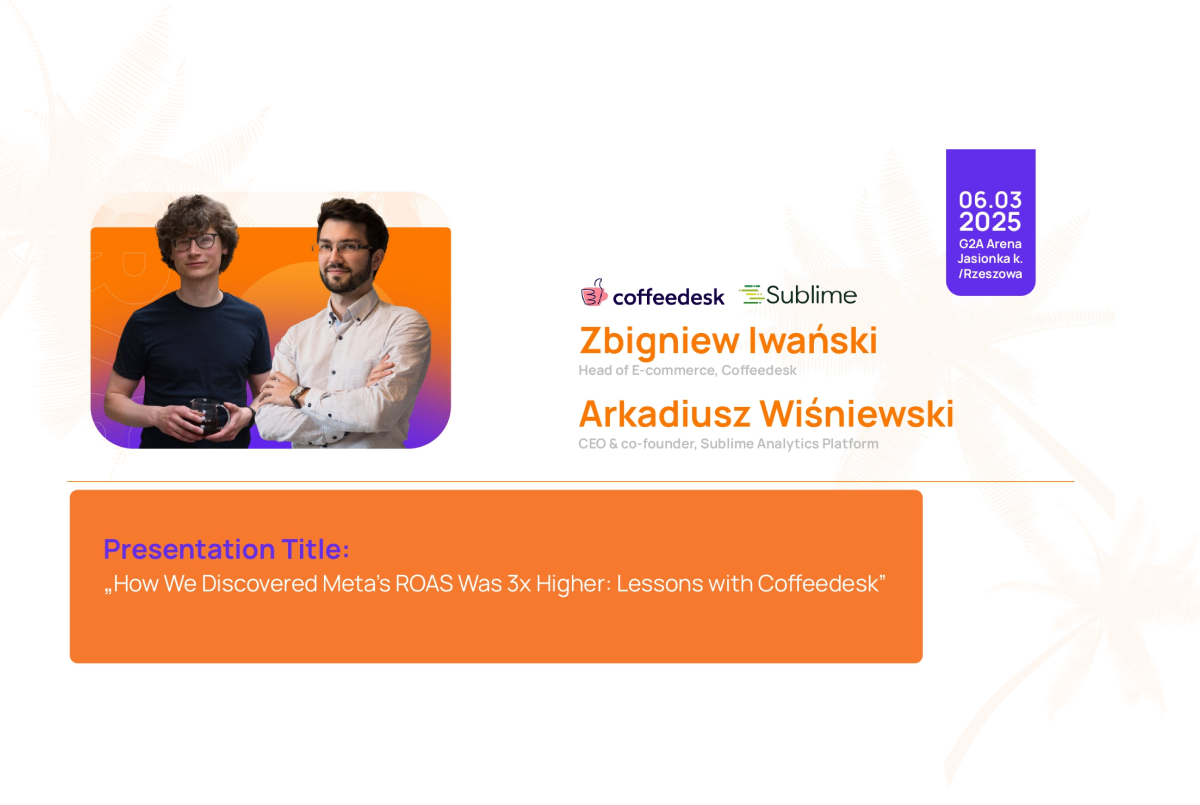Your KAYA – Meet Our Client – Growth Study
The article was written by Patrycja Kościołowska in cooperation with Sublime and originally published by enjoyGrowth!
Your KAYA is one of the fastest-growing D2C (direct-to-consumer) companies in Poland that sells products in a subscription model. It has been operating since 2017, has been externally funded and is taking over an increasing share of the market.
The idea for Your KAYA
Your KAYA, founded by Marek Gut i Kaja Rybicka-Gut, started their business with two products: tampons and intimate hygiene liquid. The key idea that guided them from the beginning was also to create products made entirely from natural ingredients.
We started with a business model and wanted to do something that would fit into a subscription. We came up with menstruation. Since it is a process that occurs in the body cyclically, it fits perfectly into the business model.
Marek Gut, Co-founder & CEO of Your KAYA
The subscription model has been popular for several years and works great for digital services (especially streaming), but in the case of Your KAYA, it concerns physical products, but it fulfills its functions. The founders not only took into account the business model, but also consumer trends:
I also won’t deny that we were closely watching what was happening overseas (…) how consumers who are a bit more accustomed to technology and new consumption methods actually start consuming. In the United States, this subscription model was gaining popularity very quickly. Amazon Prime was a huge player that paved the way for smaller companies to enter this subscription model. It has many advantages from the perspective of running a business. Of course, such as high retention, high predictability of revenue, which makes planning and budgeting easier.
Marek Gut, Co-founder & CEO of Your KAYA
However, returning to the main topic – menstruation, the Kaja mentioned an important aspect that needed to be changed:
It was appropriate for our mission. From the very beginning, we knew that we wanted to create products that could be used to make some buzz. Menstruation is ideal for this purpose because, even recently, the menstruation is shrouded in a very strong taboo. That was our idea.
Kaja Rybicka-Gut, Co-founder & Chief Brand Officer of Your KAYA
The founders had a business model and they knew the trends, but they wanted to make sure that the product would actually have market fit. They therefore approached the topic in a model-based way and built an MVP (minimum viable product), which is the minimal version of a product that can be brought to market.
We did it very textbook-style, because we actually decided to test our business before we launched it. And it actually turned out that there was a need for it, and then we started working. (…) We created a kind of mock-up of an online store that looked like a functioning store. But we didn’t have those products, so they were just scaled-up cardboard boxes to create the impression that there were more of them. We ran ads on Facebook to redirect traffic there. Those were the days when media were much cheaper, especially in social media. And we looked at how many people actually added the product to the cart. I remember we spent about 400 PLN ($100) on advertising and we had 1,500 people who eventually signed up for the waiting list. Literally in a few days.
Kaja Rybicka-Gut, Co-founder & Chief Brand Officer of Your KAYA

Business model: subscription
Your KAYA has been operating under a subscription model since its inception. At the time of the store’s launch, it was possible to purchase a subscription and place a one-time order for a starter box. In the first month, 1 subscription and 500 boxes were sold. In the second month, there were 3 subscriptions and 1,000 boxes. Subscription development is difficult, the cost of acquiring a customer in this model is even 3 times higher than with a one-time purchase, which is why the founders decided to open up to the introduction of a hybrid shopping model, meaning you can place a one-time order or decide on a cyclical one.
Currently, starter boxes are priced at 17.99 PLN ($5):

And they contain, among others:
- a day pad and a night pad or a mini, regular, and super tampon,
- a sample of intimate oil,
- a sample of intimate scrub,
- a sample of intimate hygiene liquid.
Important: Purchasing a subscription allows you to save 15% compared to one-time purchases, and this is emphasized in the communication on the website.

Lessons Learned from selling in a subscription model
Marek shared a lot of knowledge in this area:
- Frequency is a good starting point for a subscription, but the next point to verify the product is how it is purchased by consumers. For example, we often use shampoo every day, but we are prone to frequent changes, and this can be a problem when scaling.
- You don’t have to have all products adapted to the subscription, but it can be the core, as in the case of Your KAYA, which is about menstruation. These additional products will increase LTV.
- If you give big discounts, there is a risk that the user will make a purchase in the subscription and cancel the same day.
- You should find a discount level to which CR is growing and stick to it. In the case of Your KAYA, it is 15%. A 20% discount will not affect CR, but will reduce revenue.
- At Your KAYA, we only give discounts to ambassadors or when we test new channels, otherwise it is a trap.
- A subscription is always more cost-effective for a customer than a one-time purchase, even if we offer discounts.
- The goal is not the subscription, but retention and repeatability, and the subscription can help with this.
Case Study: Increasing Conversion Rate through advanced RFM segmentation
To start, here are a few key facts about Your KAYA:
- 60% (YoY) growth,
- 200K customer base,
- 60% of revenue comes from the D2C channel.
Retention is a key metric in the subscription model in order to have predictable cash flow. At Your KAYA, it is managed through two channels (marketing automation and Meta) and a loyalty program. A different strategy is used in each channel:
- Loyalty program: Customers collect points, which they can then redeem for discounts or free products.
- Referral program: A friend can receive a 15% discount, and the referrer can earn 10 PLN for the referral.


Problems Your KAYA faced:
- absence of a visible significant impact on customer retention,
- it was not clear whether conversions came from inactive or already engaged customers,
- it was difficult to determine how much of these purchases were incremental,
- the most effective campaigns included discounts, which was not surprising.
Solution:
Sublime has been working with Your KAYA since day 1, so it has a vast amount of purchase data. Based on this data, it was decided to conduct an RFM analysis, which takes into account three dimensions:
- Recency: When did the customer make a purchase last?
- Frequency: How often does the customer make purchases?
- Monetary: What is the average order value for this customer?
Each dimension is divided into five parts. Depending on the group to which customers are classified, they receive an appropriate score from 1 to 5. For example, if a customer made a transaction in the last 7 days (recency), they receive a score of 1, if 7-14 then a score of 2, etc.
Based on the data, 10 segments were defined in three main groups:

Next, a test was decided to be conducted, with the following assumptions:
- 1 segment would be tested in 1 channel → Meta was chosen first;
- the selected segment was “Falling Enthusiasm” → a group of customers who were once good customers (high frequency or purchase value), but did not make a purchase in the last 180 days;
- the media budget was divided as follows: 85% for the test group and 15% for the control group;
- CRM data was sent daily in an automated way;
- incremental revenue was calculated – this means that only 85% of the customers in the Falling Enthusists group were shown the communication. This made it possible to compare the results with 15% of the customers in the control group who did not receive the communication. This, in turn, made it possible to calculate the added/incremental value of the communication;
- the test was to last 2 weeks and include 2 communications: a loyalty program and a discount.

Results:
- 90% of the customers from the CRM database were matched with Meta users, which is a very good result (the average is 60-70%),
- incremental revenue of 21 000 PLN ($5 000) was recorded (a 38% increase compared to the control group),
- cost: 1 228 PLN ($300),
- return on ad spend (ROAS): 16
- average frequency of user contact with the ad: 5.7
- communication 2, i.e. the discount, achieved better results.
Next steps:
After the test, Your KAYA decided to use this approach in other channels as well. They are currently in the process of implementing communication based on RFM segments in marketing automation.
Business development plans
Since April 2022, selected Your KAYA products have been available in Rossmann stores, which means over 1,500 stores. This also meant entering smaller towns where the brand was not previously known. It is certainly a major logistical challenge to stock products that were previously only available online for 5 years. However, it is also a change in strategy from pure e-commerce to omnichannel, which opens up a world of possibilities.
But that’s not all. Your KAYA is hungry for more. The founders point out that:
There is a lot of potential to grow in the categories in which we are already present. We want to become a legacy player in terms of intimate hygiene on our Polish market. In addition, new product verticals are coming in and we intend to expand our portfolio significantly. The plan is to have several dozen new products in the Your Kaya offer. These will be body products and more specialized facial products.
The founders have already mentioned their desire to expand outside Poland. It seems that this topic has matured and is slowly beginning to crystallize:
Foreign markets: expansion is expensive, it’s very expensive. (…) We operate on a small scale abroad. We want to increase this scale, but we want to do it in a smart way. (…) This will involve transferring the omnichannel strategy we have in Poland to new foreign markets, without entering purely through the D2C channel. (…) We are thinking about large markets. (…) Germany is a direction we are considering.
Contents:
Contents:



